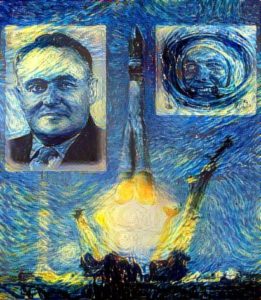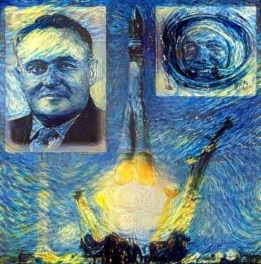On the fourth day of October, 1957, Russia put the first artificial satellite into orbit around the earth launching the Space Race.
My father told me about sitting beneath the stars and listening to the haunting beep… beep… beep… signal on his radio as he watched Sputnik sliding eerily across the night sky. Around the planet people woke up to a world changed forever. Four years later Yuri Alexeevich Gagarin became the first man to orbit the earth.
 While Yuri was posing for photographs and being written into the history books, the identity of the man responsible for both of these historic events was one of the Kremlin’s best kept secrets. He was known only as “The Chief Designer”. When he died on January 14, 1966, the Kremlin finally revealed his identity – Sergei Korolev. Had Sergei lived another two years it is possible that the USSR would have beaten us in the race to the moon as well.
While Yuri was posing for photographs and being written into the history books, the identity of the man responsible for both of these historic events was one of the Kremlin’s best kept secrets. He was known only as “The Chief Designer”. When he died on January 14, 1966, the Kremlin finally revealed his identity – Sergei Korolev. Had Sergei lived another two years it is possible that the USSR would have beaten us in the race to the moon as well.
When the Kremlin abandoned its lunar landing missions in 1974 they ordered the NK33 rocket engines built for those missions to be destroyed. Fortunately, the engineers disobeyed the order and instead hid the engines in a warehouse.
Twenty years later rumors started circulating about the missing NK33 engines. Lockheed Martin found the warehouse, and brought one of the engines to America to be tested. The American engineers were shocked to find that these Russian rocket engines designed and built in the 1960’s outperformed even our most advanced technology. It has now been 50 years since The Chief Designer died and both Russia and the US are still using refurbished NK33 engines today to launch their Soyuz and Antares Rockets.
What was the secret to The Chief Designer’s amazing success? Iterative and incremental development! Sergei Korolev did not invent Iterative and incremental development, he borrowed it from nature. Natural selection perfected iterative and incremental development long before humans looked up at the night sky and dreamed of traveling to the stars. Nature did not start with a perfect design. It started with proteins and fatty acids, and then incrementally, thru countless incarnations of ever increasing complexity, evolved them into creatures capable of dreaming.
In the West, we attempted to perfect our rocket designs on the drawing board before ever moving forward to construction. The Western emphasis on getting it right the first time works well in simple systems that can be understood and modeled. But increasingly, engineers are faced with complexities and emergent phenomenon that mock our attempts to predict in advance.
Under the leadership of The Chief Designer, Russian engineers spent far less time on the initial design. Instead the plans were given to the manufacture engineers on the factory floor where the rocket engines were built. Through testing they identified the flaws, then refined and built and tested and refined and built and tested… repeating until the rockets finally flew. Of course, there were lots of spectacular explosions on the test pad along the way.
Nasa took those explosions as evidence of Russian engineering incompetence. But the truth is each exploding rocket moved The Chief Designer one step closer to a rocket that would work culminating in the NK33 engine that, 50 years later, is still lifting payloads into space.
Here is a simple algorithm for learning.
- Push into the Unknown;
- Do something;
- Wait for feedback;
- Adjust accordingly;
- Repeat process until successful.
I approach writing in this manner. Rather than trying to get it right in my head before I write the first word, I have learned to just start writing. Through the process of writing the message emerges. Through multiple incremental revisions I fix most of the problems until the piece can stand on its own. In the end, it is the surviving imperfections that imbue the writing with character.
I practice yoga in much the same way. I do not wait for understanding to practice Yoga. I practice Yoga to gain understanding. Much like those Russian rocket scientists, I learn on the job, experientially. Through successive incremental iterations I continue to try new things and learn from mistakes as my personal practice evolves. Namaste’
2 Comments
-
I love the story and the idea it reveals to us.
Thanks for sharing!
Peace, health and love to you,
Chrystel -
Thanks Charles!!
Gorgeous approach
Share on FB
Best wishes






